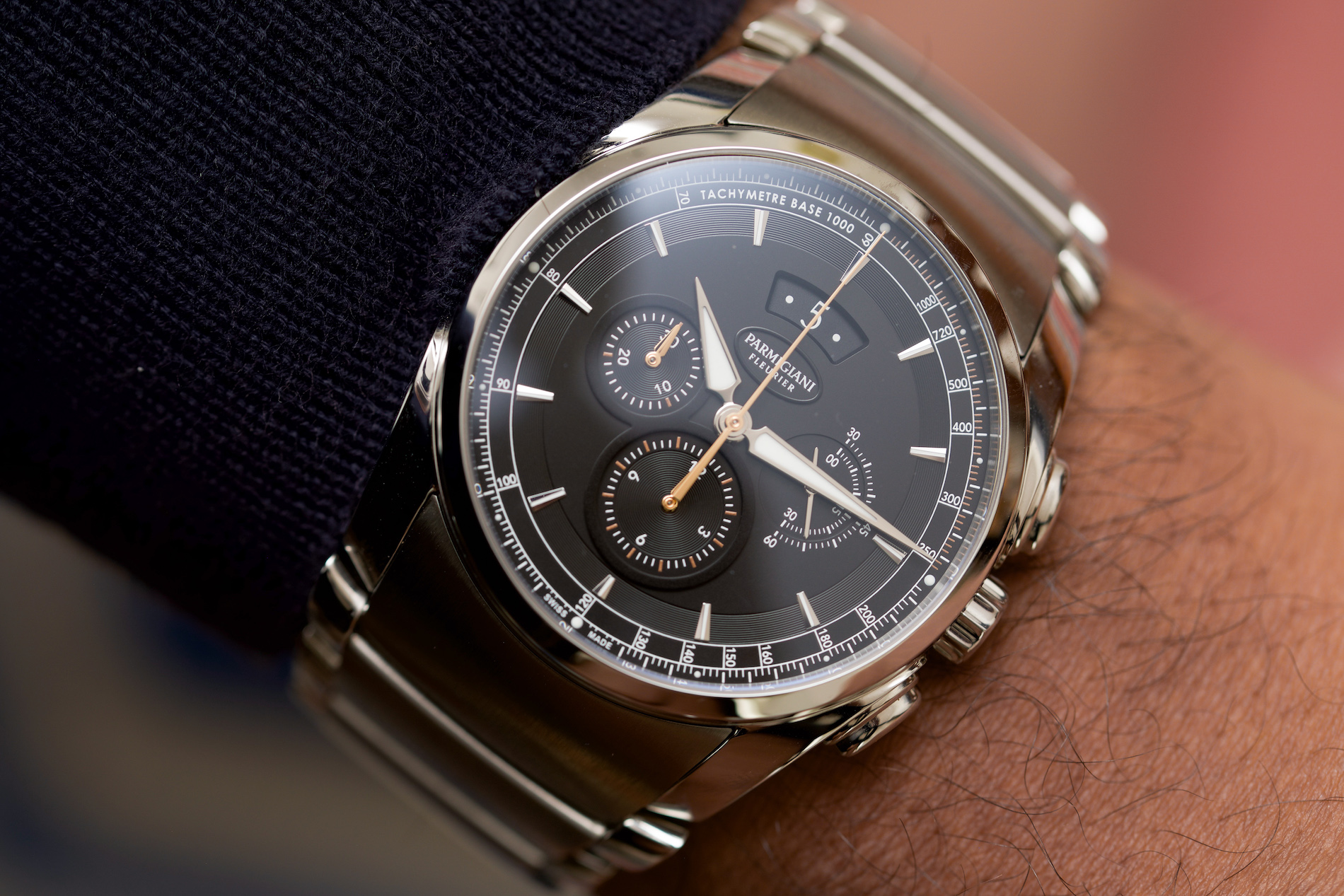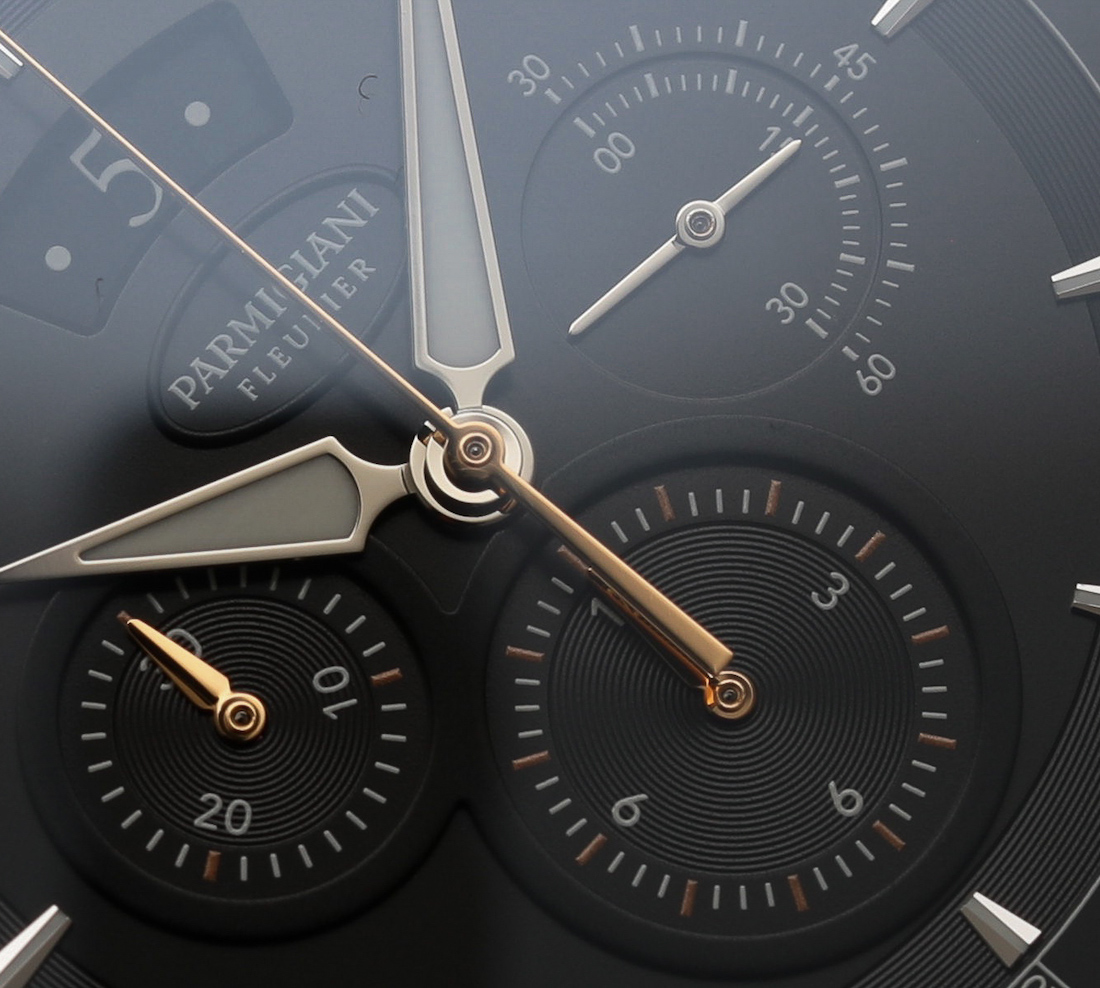 Parmigiani Fleurier knows that given their production numbers, they can take the risk of love or hate aesthetic decisions – like the triple date aperture, which thankfully has been moved from 6 o’clock to 12 o’clock. In theory, I have no issue with a triple date window, but my opinion is almost entirely guided by execution. Some of IWC’s previous triple date windows looked absolutely terrible and ruined otherwise handsome pilots watches, but I love the aperture on this Parmigiani. I think the positioning at 12 o’clock has a lot to do with this, like with a day of the week aperture. A nice touch is that the 1st of the month is done in red.
Parmigiani Fleurier knows that given their production numbers, they can take the risk of love or hate aesthetic decisions – like the triple date aperture, which thankfully has been moved from 6 o’clock to 12 o’clock. In theory, I have no issue with a triple date window, but my opinion is almost entirely guided by execution. Some of IWC’s previous triple date windows looked absolutely terrible and ruined otherwise handsome pilots watches, but I love the aperture on this Parmigiani. I think the positioning at 12 o’clock has a lot to do with this, like with a day of the week aperture. A nice touch is that the 1st of the month is done in red.
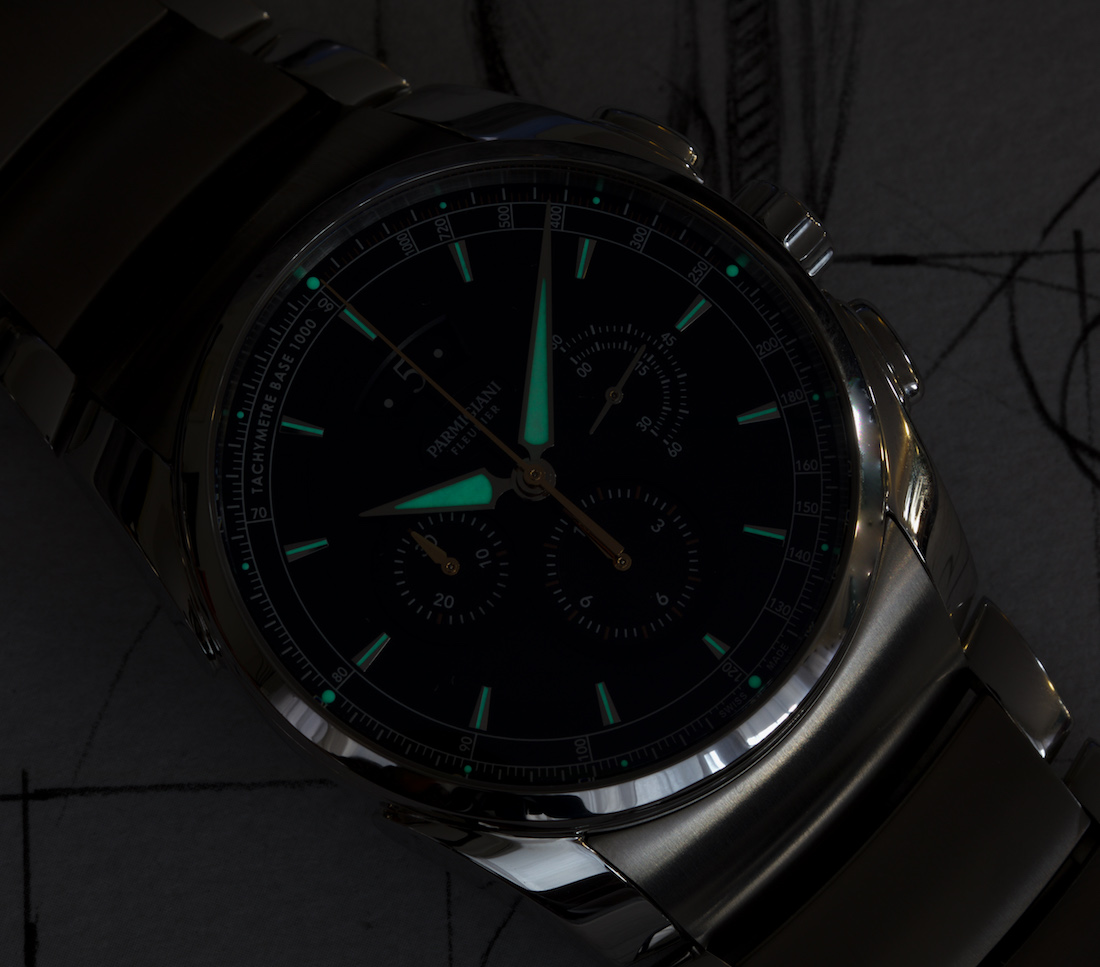
The Parmigiani Fleurier Tonda Métrographe’s “Delta” shaped hands are done with a rose gold outline, while the chronograph hand and sub-dial hands are done in all gold. The hands are done incredibly well and better than anything I’d consider to be competition, an opinion which is based in the reality of the execution but also a strong personal bias towards these Delta hands. Before wearing the watch, I presumed that legibility might be an issue. Surprisingly, the Métrographe is highly legible even in bright conditions that can make glare a nightmare. There is also just enough lume on the hands and hour markers without the aforementioned distraction from the heavy sub-dial lume from the outgoing model.
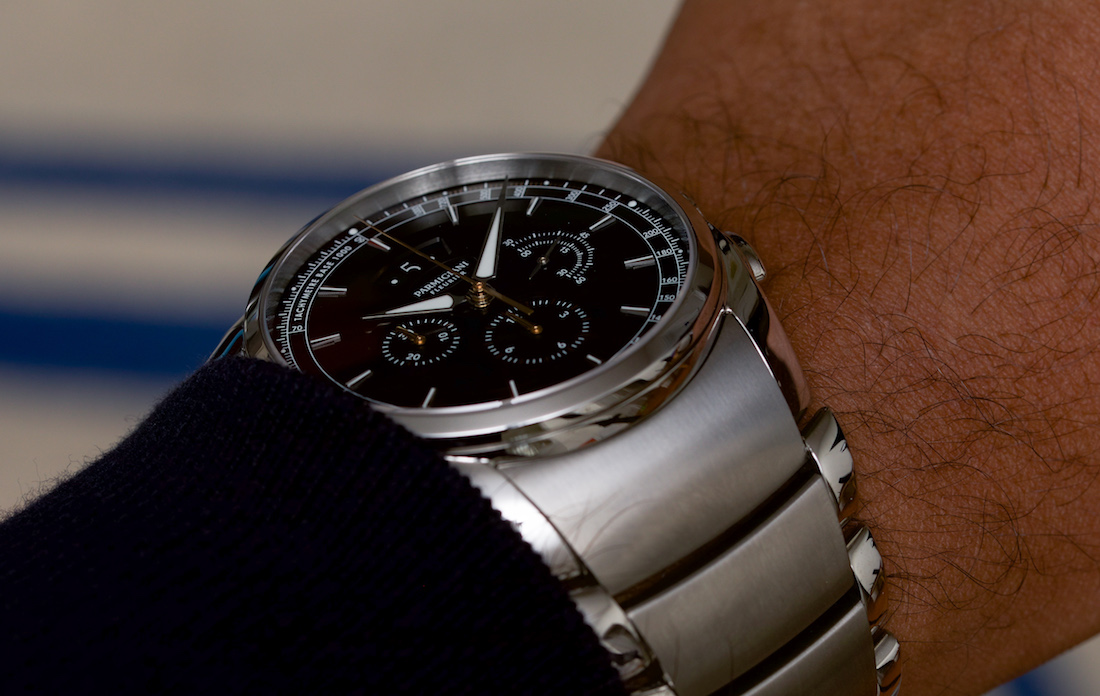
Parmigiani Fleurier deserves a lot of credit for the thoughtful refresh on the dial of the Métrographe. While I can’t speak to things like legibility on the white dial model, the overall redesign is a success by any standard. It’s tough to balance the dressy chronograph identity, but I can’t frankly think of many other options that do it as well as this.
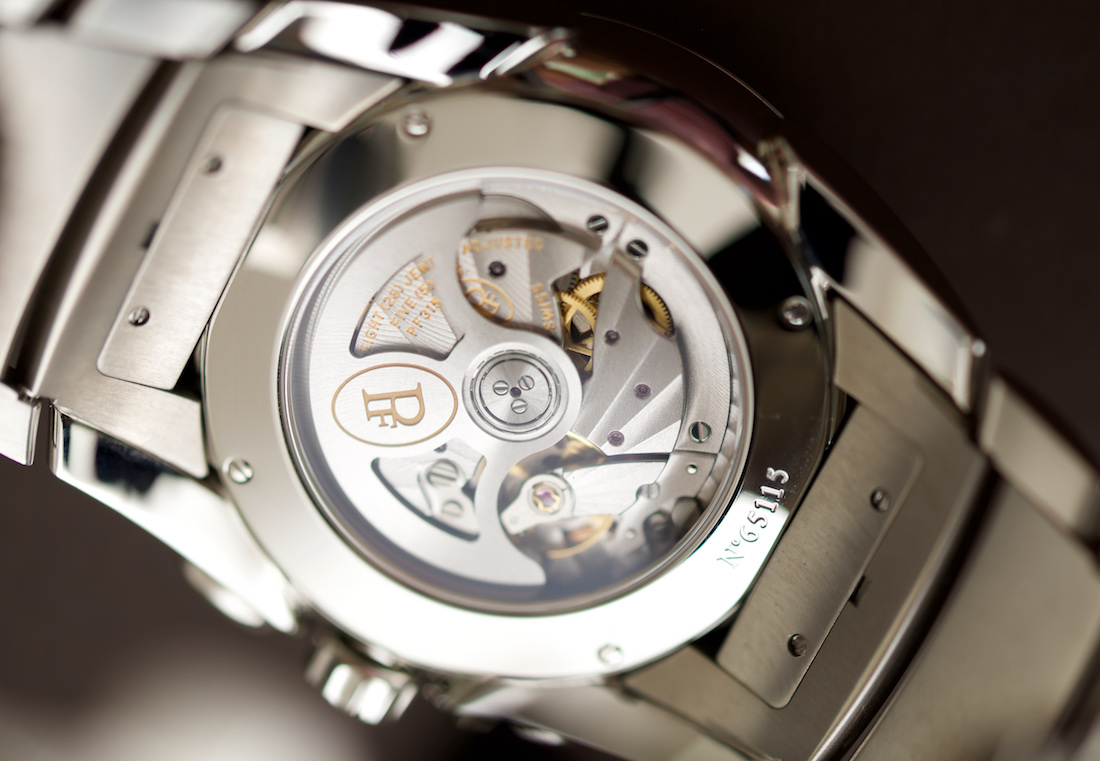
THE PARMIGIANI FLEURIER TONDA MÉTROGRAPHE PF315 MOVEMENT
It’s when considering the movement in the Métrographe that the realization that this is an entry-level Parmigiani watch is made abundantly clear. For a brand known for some of the most beautifully finished in-house movements that verge on works of art, the caliber PF315 used here achieves handsome competence. It’s not always fair to be judged by the overachievers in the family, but that just is the undeniable case when it comes to Parmigiani.
For the sake of reference, I’d look at the PF361 movement as one of their premier chronograph movements in a non-Kalpa case. An in-house, integrated split-seconds chronograph movement that operates at a high-beat 5Hz done in all 18k gold bridges, the PF361 is a total “power move” of a movement. The watch that this movement debuted in came in a limited edition run of 25 pieces, each priced at $135,000. So, let’s move back to the entry-level PF331 used in the Parmigiani Fleurier Tonda Métrographe.
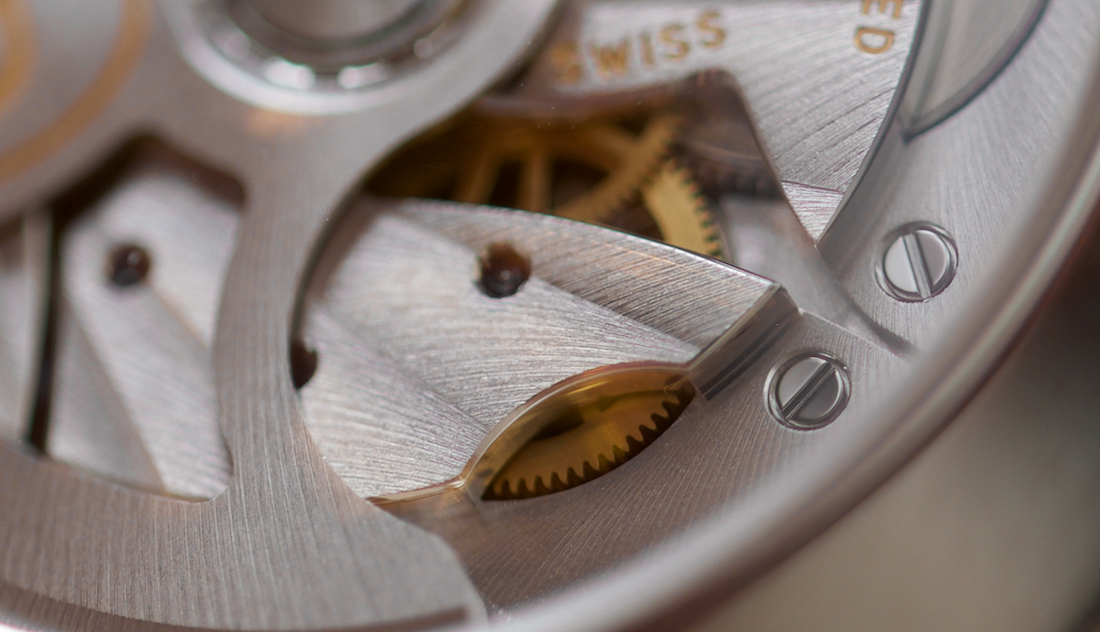
A base in-house PF331 movement with a Dubois Depraz chronograph module, the PF315 is the best possible solution to the reality that comes with the difficulty in making a completely in-house chronograph movement. On top of that, if (and likely when) Parmigiani does create one, it will come at a price point that would far exceed that which the Métrographe is aiming for. It is capable, however, operating at 28,800 vph with a middle-of-the-road 42-hour power reserve.
You can see the PF315 through the exhibition caseback and while it’s very nicely done with the Parmgiani logo, Cotes de Geneve, and gold touches, one can tell that this is a machine finished movement. Again, the standout movements created by Parmigiani are all hand-finished and the cost increase that this would involve would further push the Parmigiani Fleurier Tonda Métrographe out of this price range.
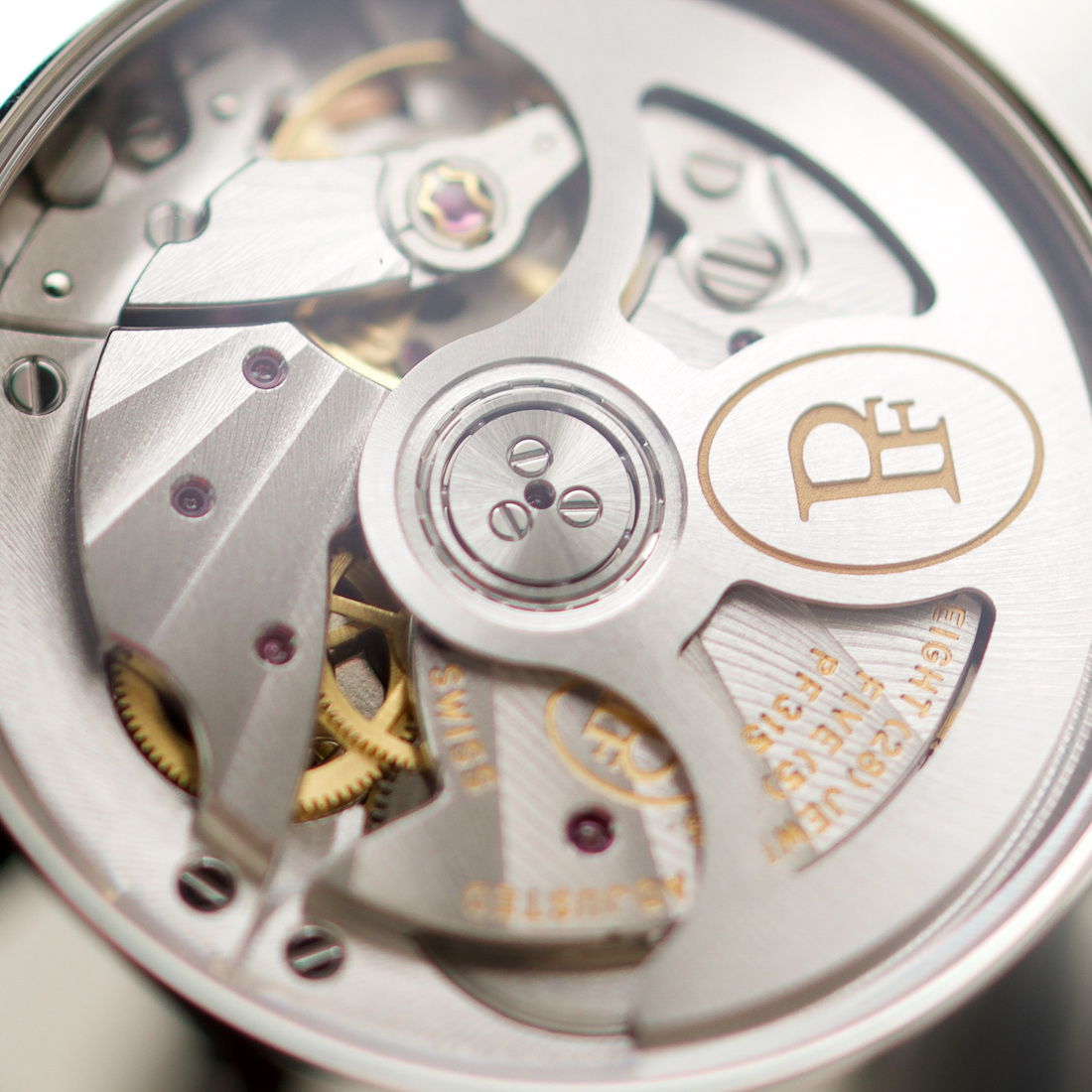
All in all, the PF315 is an entry-level movement from a brand that is known for making some truly astounding movements. While I personally am not an in-house movement purist, it somewhat does come with the territory when discussing Parmigiani. But, all factors (including economic ones) considered, I it’s a good compromise. One suggestion I would make is that a little bit more visual flair and detail would go a long way, and that improvement seems far more feasible than a totally new movement.
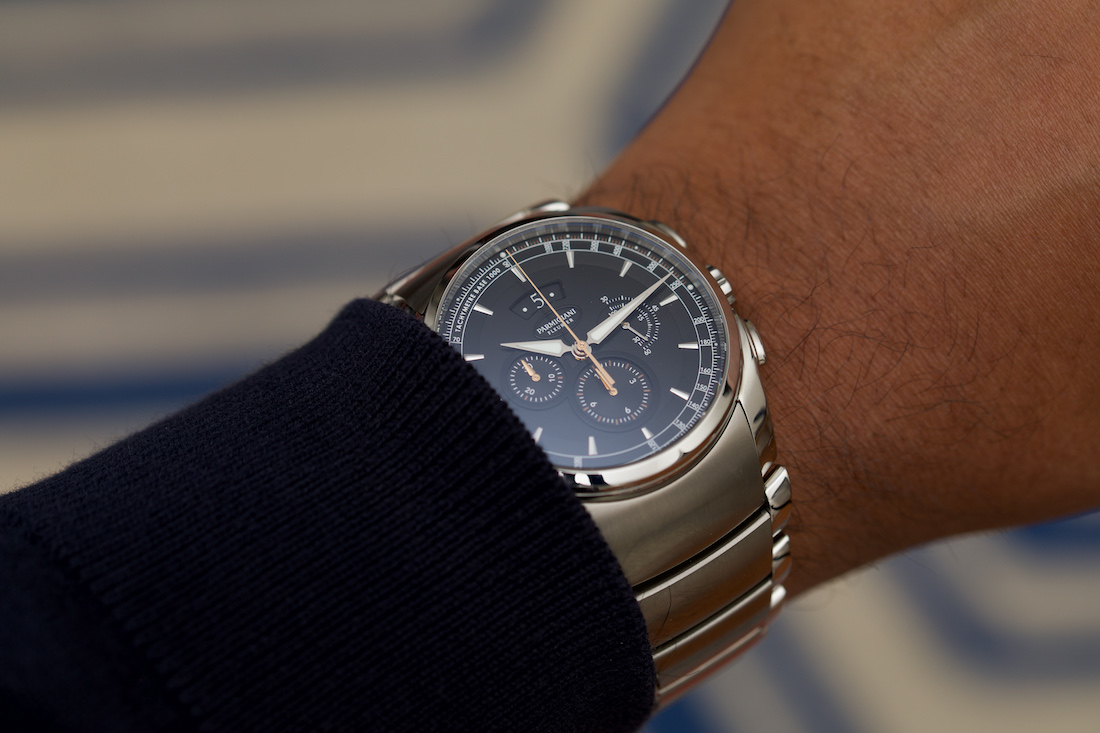
PARMIGIANI FLEURIER TONDA MÉTROGRAPHE COMPETITION
It was tough to really think of a watch that I would consider a direct competitor since the Métrographe is such a niche and specific watch. I usually prefer to keep comparison sections a little smaller, but I think that does a disservice to the luxury chronograph category since there are those that are dressier than the Métrographe and those that are sportier than it. They are still competitors, though. But first, let’s look at what I’ll call the ‘usual suspects’ and the one watch that I think gets closest to offering the style of design-oriented dress chronograph that the Parmigiani Fleurier Tonda Métrographe does.
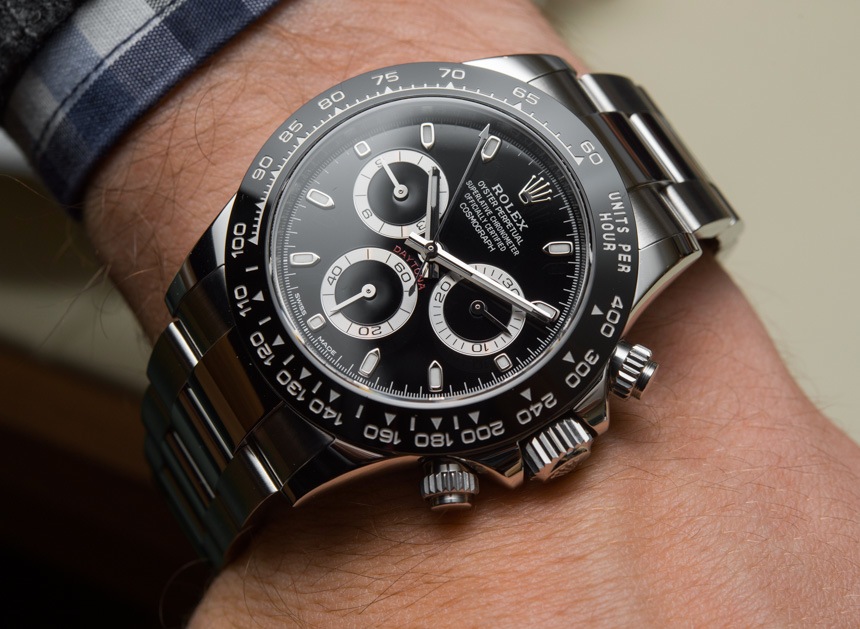
THE USUAL SUSPECTS
I’ve mentioned the Rolex Daytona, which is priced at $12,400 but good luck getting it at retail (as of 2018, at least). It’s not going to get any points for originality but the combination of brand appeal, “iconic” status, and legendary quality associated with the Crown put this one right at the top of the list. I have a feeling that a Daytona buyer usually wants a Daytona, period, and is not practically weighing one against a niche, small-production watch from a brand who is known to a much more niche and horologically sophisticated crowd.
The other usual suspect is the Audemars Piguet Royak Oak Chronograph which somehow is capable of simultaneously being a “safe pick” that has a legendary and unique design. Then again, at $24,500 it’s twice the price with a decades-old non in-house, modified F. Piguet 1185 (caliber 2385) movement that is notoriously costly to service. Then again, one of the best bracelets out there, the Genta design, and that Big Dog status in the luxury chronograph world all come together to create an aspirational piece that essentially stands alone.
I would add the Vacheron Constantin Overseas Chrongraph here, but at $30,200 it is way out of this category, which the Royal Oak was already pushing the boundaries of.
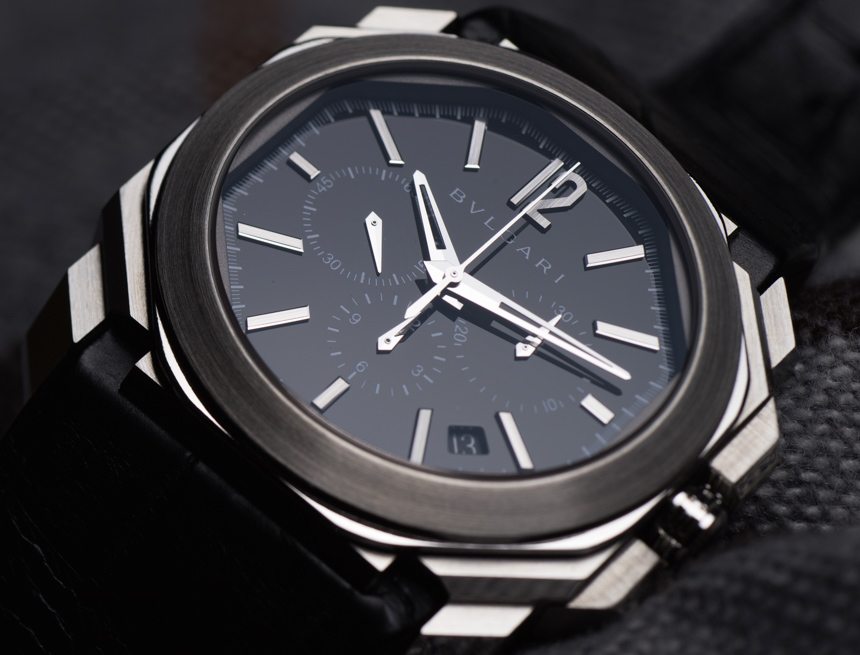
THE CLOSEST COMPETITOR (IN MY OPINION, AT LEAST)
The Gerald Genta designed Bulgari Octo Velocissimo Chronograph is another watch that is all about the details that go into its design. I see it as the closest competition for the Parmigiani Fleurier Tonda Métrographe, actually. A complex and masterfully finished case with the option of a pretty stunning bracelet (or strap, as well), the Octo leans more towards someone who prefers sharp angles and a more aggressive look. Still, it is distinctly dressy and refined even with a 41mm case that wears larger due to its shape.
The Octo Velocissimo uses a BVL 328 movement which is essentially a borrowed El Primero movement from LVMH sibling Zenith. It operates at 5Hz, 36,000 vph, and gets a 50-hour power reserve. It’s a solid and obviously well-regarded movement that also serves as a reminder that Bulgari is a big brand within the umbrella of a giant conglomerate. At the end of the day, the choice between the Octo Velocissimo or Métrographe comes to a draw for me, with deciding factors being aesthetic preference or the choice between niche/independent or a luxury powerhouse.
The Bulgari Octo Velocissimo is priced at $9,900 on a leather strap and $10,400 on the excellent steel bracelet.
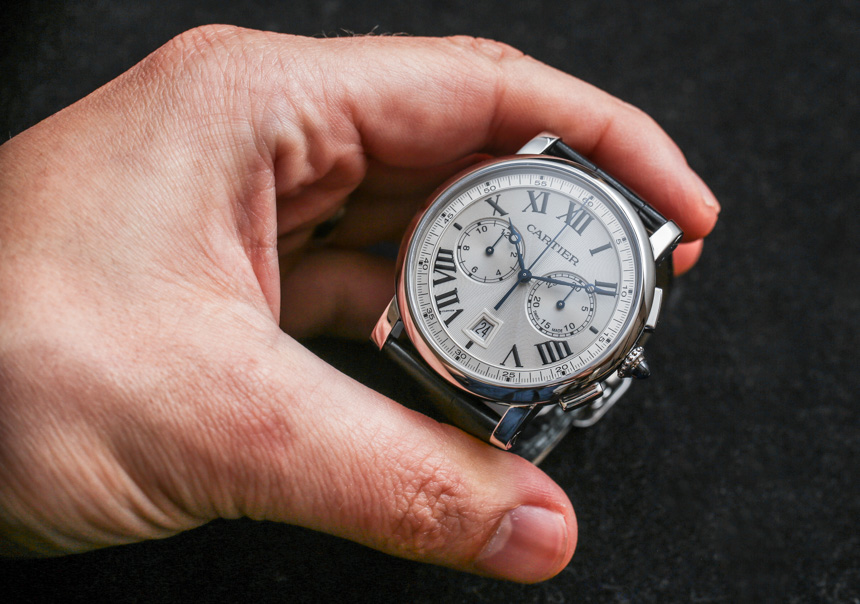
DRESSIER COMPETITORS
A bit more traditional and conservative than the Parmigiani Fleurier Tonda Métrographe and others mentioned here, the Cartier Rotonde Chronograph goes for the old-school look in a chronograph. The rectangular pushers, crown with blue cabochon, and extensive guilloche work on the dial all come together for a watch that is unmistakably Cartier in its style. And that’s fine as Cartier is one of the biggest global names in luxury watches and there’s no shame in wanting to convey this to the world.
Movement-wise the Cartier calibre 1904-CH MC is their workhorse automatic chronograph. It looks nice enough through the exhibition caseback, but it’s less well-finished when compared to the Parmigiani. A more buttoned up dress chronograph, the Cartier Rotonde Chronograph is priced at $9,050 on a leather strap.
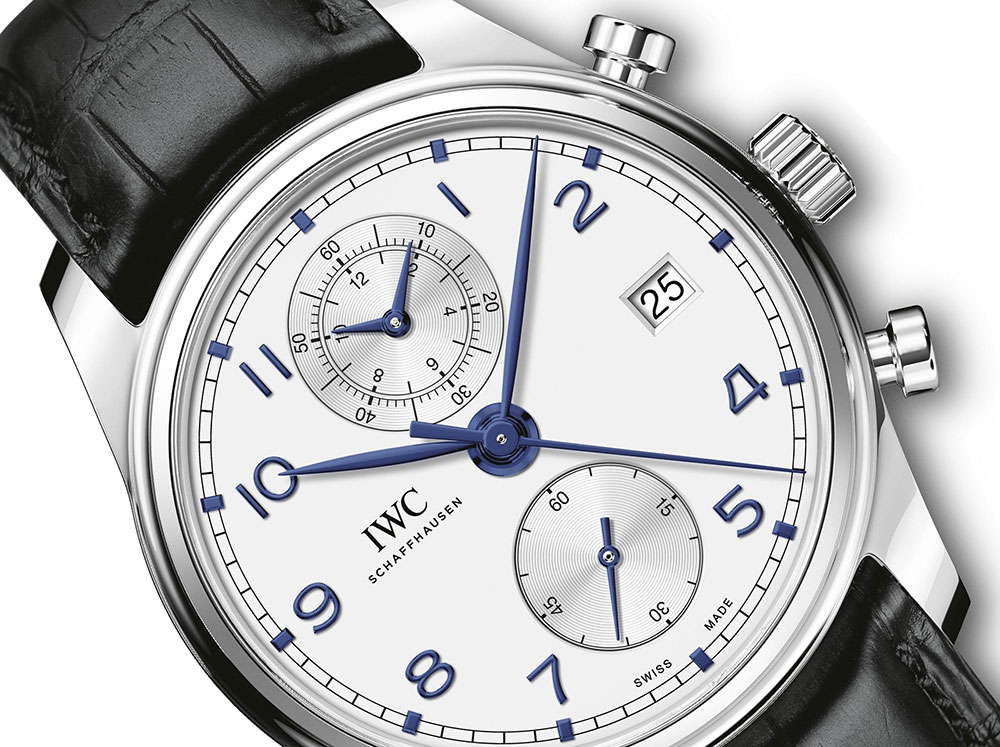
The standard IWC Portugieser Chronograph is a good fit for someone who wants a dressy chronograph but doesn’t want to pay a five-figure prices. For just over $7,000 it’s a decent value but delivers mostly in style but has a mediocre movement that IWC doesn’t even bother to show with a closed steel caseback. However, the Portugieser Chronograph Classic has the very well-finished calibre 89361 which has the added trait of being a flyback chronograph.
Personally, IWC Pilot’s watches are what appeal to me most from the brand, but this is a solid dress chronograph. The dial and case are not near the Parmigiani Fleurier, but in terms of movement the IWC has the advantage. Overall, it will appeal to more people but I honestly think that’s because it’s a pretty generic watch when you compare it to the other competitors I’ve mentioned. Priced at $12,100, the IWC Portugieser Chronograph is essentially the same price as the Parmigiani Fleurier Tonda Métrographe. I know which one I’d pick.
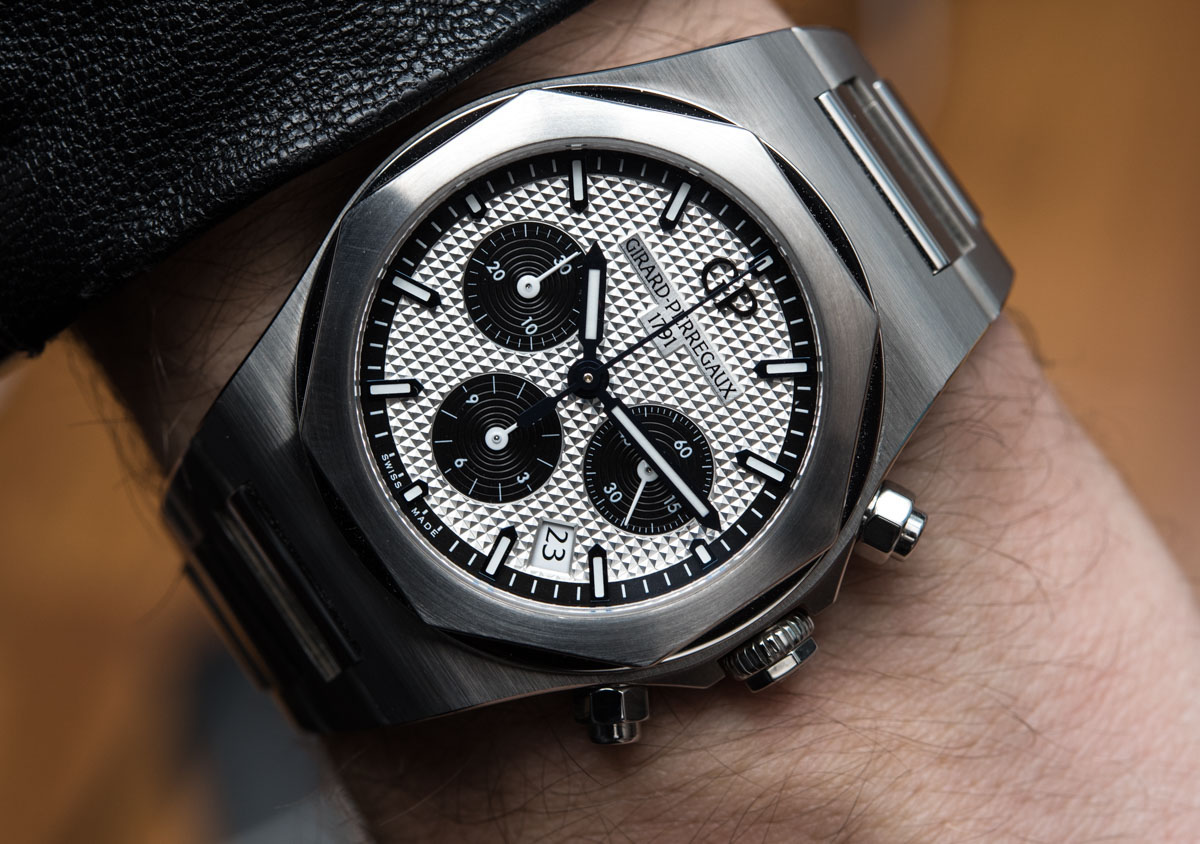
SPORTIER COMPETITORS
The smaller Girard-Perregaux Laureato Chronograph in 38mm is an all-around outstanding watch that’s too often unfairly cast as an “also ran.” GP has refined the Laureato over the years, with a 904L steel case, really impressive hobnail pattern on the dial, and overall attention to detail. On the other hand, the movement will levy the same complaints as the Métrographe or Royal Oak with a hefty price tag approaching $15,000.
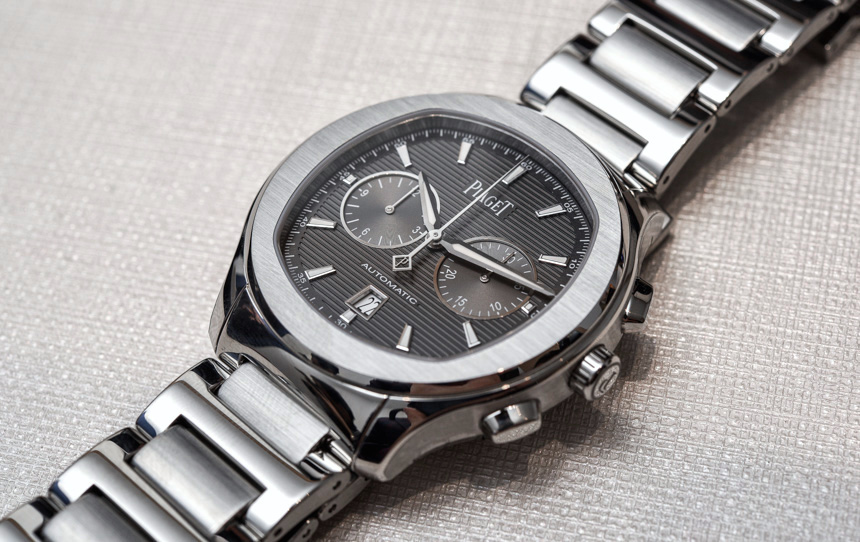
The Piaget Polo S chronograph is the other pick and has the finishing and quality that you’d expect from all the pieces I’ve mentioned here. Though it’s been some time since I handled it in person, I did appreciate the thinness of the case and looking into it now I see that it is 11.4mm thick. The thick, distinct bezel gives the Polo S its own style, though the 1160P movement is essentially the same of that in the Cartier I previously mentioned, with the finishing being just mediocre. At $12,400 it’s the same price as the Parmigiani Fleurier Tonda Métrographe. With most of these picks, it will come down to taste in design.
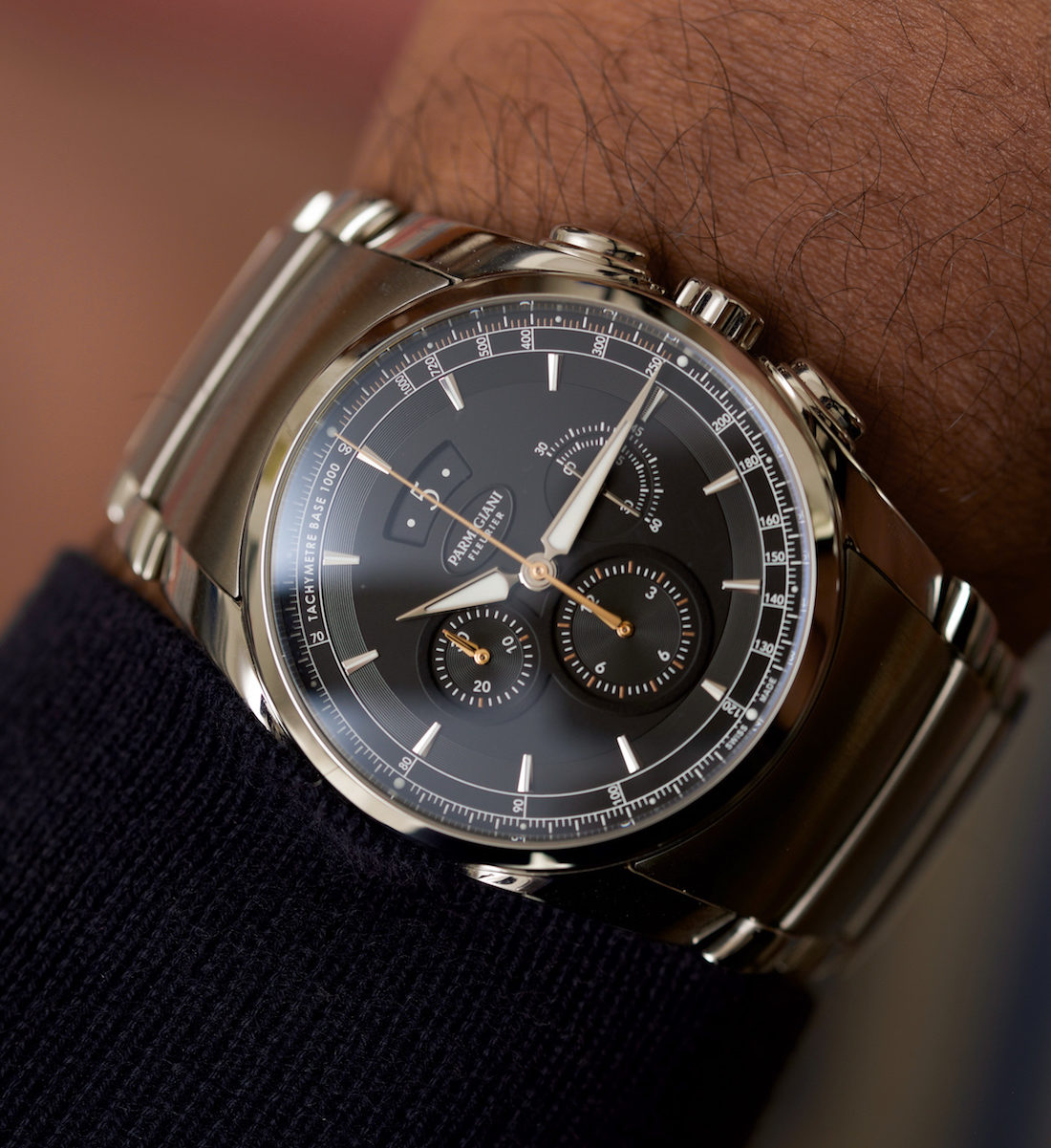
PARMIGIANI FLEURIER TONDA MÉTROGRAPHE FINAL THOUGHTS
Being the entry-level watch from a brand like Parmigiani Fleurier isn’t the most enviable position to be in. It’s a brand that requires significant effort to fully understand and appreciate, and seemingly has no desire to be mainstream in either sales or brand perception. And if you are part of the pool that is knowledgeable about Parmigiani, you likely know that one of their most defining traits is their movement finishing. You’ll get a taste of that with the PF315, but know that you’re paying quite a bit for an appetizer.
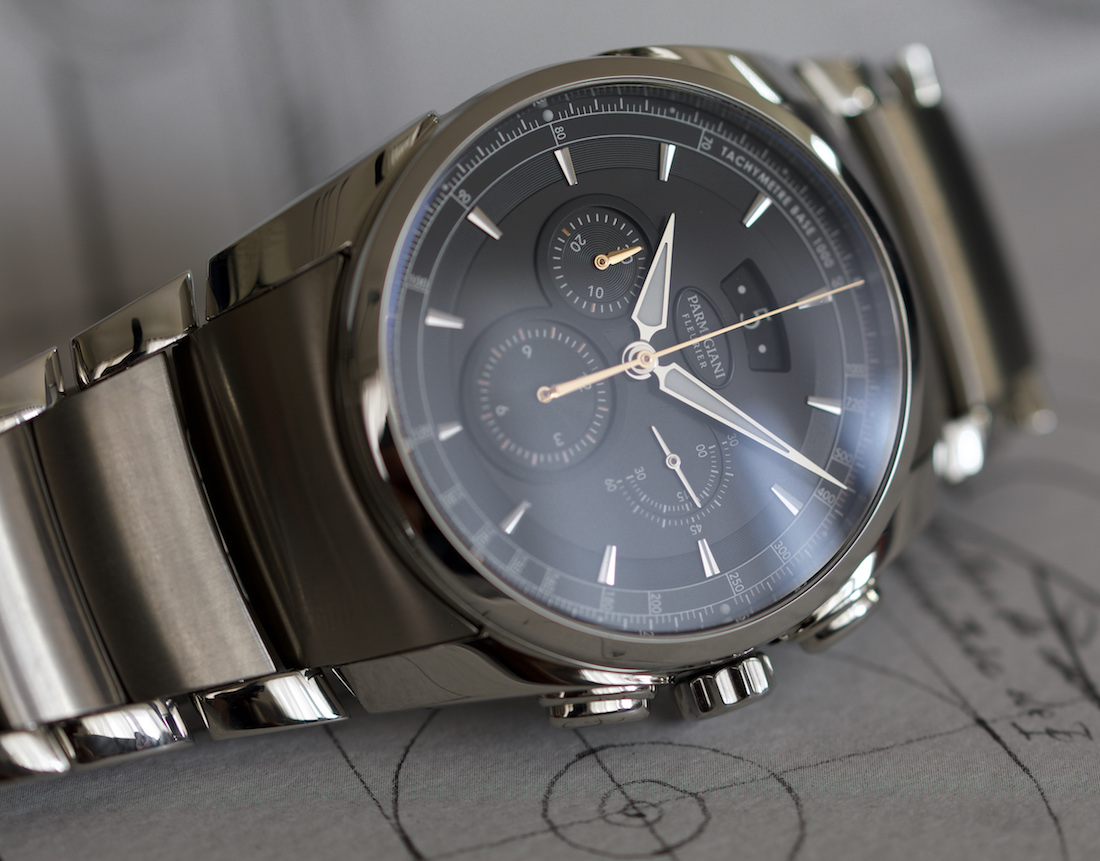
If you look at the Parmigiani Fleurier Tonda Métrographe and don’t like the design, then that’s okay because it’s not for everyone. Michel Parmigiani is singular-minded in his design philosophy and not much decision making in this regard is done by committee. This is precisely why Parmigiani Fleurier has a following that consists of so many collectors: if you like it, you love it and if you can afford one, you can likely afford more. The Métrographe is a great entry to the brand for new collectors but it’s also an everyday wear that could get a scratch or two and it won’t be the end of the world.
Priced at $11,500 on an Hermes leather strap and $12,000 on the steel and titanium bracelet I reviewed, the Parmigiani Fleurier Tonda Métrographe is equally delightful to wear as it is to admire. parmigiani.com
Necessary Data
>Brand: Parmigiani Fleurier
>Model: Tonda Métrographe
>Price: $12,000
>Size: 40mm wide & 11.7mm thick. 46mm lug-to-lug. 24mm lug width
>Would reviewer personally wear it: Yes.
>Friend we’d recommend it to first: Open-minded collector who is bored of the usual offerings.
>Best characteristic of watch: Case/bracelet design.
>Worst characteristic of watch: Movement could use more visual refinement.

